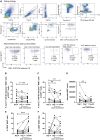Mucosal-associated invariant T (MAIT) cell responses in Salmonella enterica serovar Typhi strain Ty21a oral vaccine recipients
- PMID: 40224569
- PMCID: PMC11993846
- DOI: 10.1093/oxfimm/iqaf002
Mucosal-associated invariant T (MAIT) cell responses in Salmonella enterica serovar Typhi strain Ty21a oral vaccine recipients
Abstract
Mucosal-associated invariant T (MAIT) cells are unconventional innate-like T cells abundant in human mucosal tissues and are associated with protective responses to microbial infections. MAIT cells have the capacity for rapid effector functions, including the secretion of cytokines and cytotoxic molecules. In this study, we examined the longitudinal circulating MAIT cell response to the live attenuated oral vaccine Ty21a (Ty21a) against Salmonella enterica serovar Typhi (S. Typhi). We enrolled healthy adults who received a course of oral live-attenuated S. Typhi strain Ty21a vaccine and assessed peripheral blood MAIT cell longitudinal responses pre-vaccination, and at seven days and one-month post-vaccination, using flow cytometry, cell migration, and tetramer decay assays. We showed that following vaccination, circulating MAIT cells were lower in frequency, but were more activated, and had higher levels of gut-homing marker integrin α4β7 and chemokine receptors CCR9 and CCR6, suggesting the potential of MAIT cells to migrate to mucosal sites. We found no significant differences in MAIT cell functionality, cytotoxicity and T-cell receptor avidity, except in TNF expression, which was higher post-vaccination. We show that MAIT cell immune responses are modulated post-vaccination against S. Typhi. This study contributes to our understanding of MAIT cells' potential role in oral vaccination against bacterial mucosal pathogens.
Keywords: Mucosal-associated invariant T (MAIT) cells; Salmonella enterica serovar Typhi; chemokine receptors; mucosal tissue; typhoid fever; vaccination; vaccine.
© The Author(s) 2025. Published by Oxford University Press.
Figures




Similar articles
-
Cross-reactive multifunctional CD4+ T cell responses against Salmonella enterica serovars Typhi, Paratyphi A and Paratyphi B in humans following immunization with live oral typhoid vaccine Ty21a.Clin Immunol. 2016 Dec;173:87-95. doi: 10.1016/j.clim.2016.09.006. Epub 2016 Sep 12. Clin Immunol. 2016. PMID: 27634430 Free PMC article.
-
Challenge of Humans with Wild-type Salmonella enterica Serovar Typhi Elicits Changes in the Activation and Homing Characteristics of Mucosal-Associated Invariant T Cells.Front Immunol. 2017 Apr 6;8:398. doi: 10.3389/fimmu.2017.00398. eCollection 2017. Front Immunol. 2017. PMID: 28428786 Free PMC article.
-
Age-Associated Heterogeneity of Ty21a-Induced T Cell Responses to HLA-E Restricted Salmonella Typhi Antigen Presentation.Front Immunol. 2019 Mar 4;10:257. doi: 10.3389/fimmu.2019.00257. eCollection 2019. Front Immunol. 2019. PMID: 30886613 Free PMC article.
-
Mucosal-Associated Invariant T Cell Interactions with Commensal and Pathogenic Bacteria: Potential Role in Antimicrobial Immunity in the Child.Front Immunol. 2017 Dec 15;8:1837. doi: 10.3389/fimmu.2017.01837. eCollection 2017. Front Immunol. 2017. PMID: 29326714 Free PMC article. Review.
-
Mucosal-Associated Invariant T Cells in Autoimmune Diseases.Front Immunol. 2018 Jun 11;9:1333. doi: 10.3389/fimmu.2018.01333. eCollection 2018. Front Immunol. 2018. PMID: 29942318 Free PMC article. Review.
References
LinkOut - more resources
Full Text Sources
